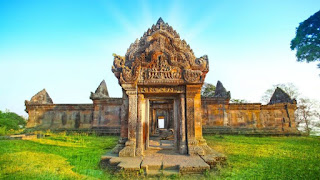Preah Vihear Temple (Khmer: ប្រាសាទព្រះវិហារ Prasat Preah Vihear) is an ancient Khmer temple built during the period of the Khmer Empire, that is situated atop a 525-metre (1,722 ft) cliff in the Dângrêk Mountains, in the Preah Vihear province, Cambodia. In 1962, following a lengthy dispute between Cambodia and Thailand over ownership, the International Court of Justice (ICJ) in The Hague ruled that the temple is in Cambodia.
Affording a view for many kilometers across a plain, Prasat Preah Vihear has the most spectacular setting of all the temples built during the six-century-long Khmer Empire. As a key edifice of the empire's spiritual life, it was supported and modified by successive kings and so bears elements of several architectural styles. Preah Vihear is unusual among Khmer temples in being constructed along a long north–south axis, rather than having the conventional rectangular plan with orientation toward the east. The temple gives its name to Cambodia's Preah Vihear province, in which it is now located, as well as the Khao Phra Wihan National Park which borders it in Thailand's Sisaket province, though it is no longer accessible from Thailand. On 7 July, 2008, Preah Vihear was listed as a UNESCO World Heritage Site.
The temple was built at the top of Poy Tadi, a steep cliff in the Dângrêk Mountain range which is the natural border between Cambodia and Thailand. The Temple is currently listed by Cambodia as being in Svay Chrum Village, Kan Tout Commune, in Choam Khsant District of Preah Vihear Province of northern Cambodia. The temple is 140 km from Angkor Wat and 418 km from Phnom Penh.
Location
The Temple was listed by Thailand as being in Bhumsrol village of Bueng Malu sub-district (now merged with Sao Thong Chai sub-district), in Kantharalak district of the Sisaket Province of eastern Thailand. It is 110 km from the Mueang Sisaket District, the center of Sisaket Province. In 1962 the ICJ ruled that only the temple building belonged to Cambodia, while the direct way to access the temple was from Thailand, but currently, as of at least 2015, the only access is from inside Cambodia.
History
Construction of the first temple on the site began in the early 9th century; both then and in the following centuries it was dedicated to the Hindu god Shiva in his manifestations as the mountain gods Sikharesvara and Bhadresvara. The earliest surviving parts of the temple, however, date from the Koh Ker period in the early 10th century, when the empire's capital was at the city of that name. Today, elements of the Banteay Srei style of the late 10th century can be seen, but most of the temple was constructed during the reigns of the Khmer kings Suryavarman I (1006–1050) and Suryavarman II (1113–1150). An inscription found at the temple provides a detailed account of Suryavarman II studying sacred rituals, celebrating religious festivals and making gifts, including white parasols, golden bowls and elephants, to his spiritual advisor, the aged Brahmin Divakarapandita. The Brahmin himself took an interest in the temple, according to the inscription, donating to it a golden statue of a dancing Shiva known as Nataraja. In the wake of the decline of Hinduism in the region the site was converted to use by Buddhists.
(FOR MORE DETAIL - https://en.wikipedia.org/wiki/Preah_Vihear_Temple )






No comments:
Post a Comment